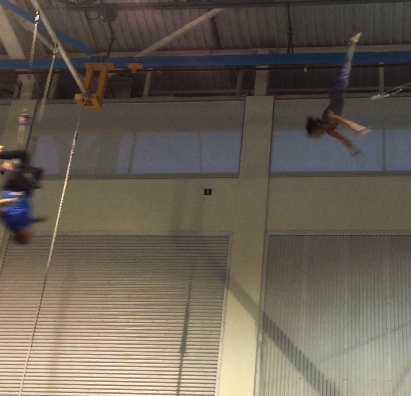"How are your hands?"
I can't even count on both hands how many times I've heard that phrase around the rig. Also common is hearing the follow up phrase, "Let me see." (translation: how much more flying can you do before we have to call it quits for the day?)
The trapeze flyer's hands tell a story. Take one look at a trapezist's hands and you'll see their journey marked across the palm in a bumpy and crooked path, dotted with extreme highs and lows. Their hands are a visual representation of all the hard work and literal blood and sweat that was shed along the way. They are a symbol of pride and every callus and blister is worn as a badge of honor.
While roughed up, callused hands are much desired, they do take some time and consistent flying to build up. And at some point every flyer will experience the dreaded rip. And flyer be warned, washing your brand new oozing tear will be painful enough to make you want to cry and never wash your hands again...just kidding. But they will be uncomfortable and possibly cause some unwanted down time. Flyers work their hands pretty hard on the trapeze (and on other bar-based apparatuses).
We rely on our hands, yet we sometimes don't treat them so well.
We rely on our hands, yet we sometimes don't treat them so well.
As flyers we should probably strive to avoid rips altogether, yet sometimes we just push ourselves beyond what our hands can handle and the result is less than ideal. My hands usually warn me when to start easing off during practice and I know well enough to listen to them, but being so eager to fly, half the time I end up throwing caution to the wind, pushing my hands well past their limits. And in true-to-me form, I don't stop flying until my hands literally
cannot take it anymore.
Don't be like me, listen to your body.
Don't be like me, listen to your body.
Grips are great ways to prevent rips. There are a variety of leather grips that are commonly used. Until recently, I was flying on palm guards-style grips that I picked up at Trapeze Texas (formally Trapeze Austin). However, earlier this year I ditched the grips in favor of flying bare-handed because I was flying primarily on gauze-taped bars and I loved how it felt in my hands. After some time off from flying, the calluses I had built up softened and peeled off, which made flying difficult for me. My hands were getting red hot so fast! I wanted to swing and swing and swing, but my hands were screaming NO and NO and HELL NO. So I found myself fastening some tape grips on the fly (hehe trapeze pun) to help prevent (prolong) blistering and ripping. These are the types of grip I typically make:
Recently, I made the transition into wearing dowel gymnastics grips. Prior to purchasing my grips, I spent some time researching and discussing the different styles of dowels before selecting a pair that would meet my needs. I've heard many mixed feelings about the usage of dowels and the proper type necessary for flying trapeze. I've heeded the warnings about the dangers and listened to the suggested benefits of using them. Ultimately, I went with a pair that felt right for me and so far I'm pretty happy with them. I've only used them during one training session, but they did save my hands and I was able to fly for about four hours with only minimal discomfort. I did end up ripping on my very last swing though. I'm looking forward to continuing the dowel grip flying experiment.
Hopefully, the next time someone asks me, "how are your hands," I won't reply, "they hurt, I only have a one or two more swings in me" or even worse, "they ripped."
Hopefully, the next time someone asks me, "how are your hands," I won't reply, "they hurt, I only have a one or two more swings in me" or even worse, "they ripped."







